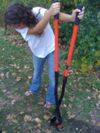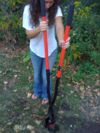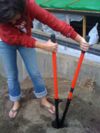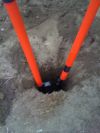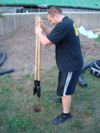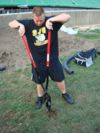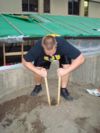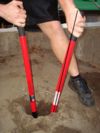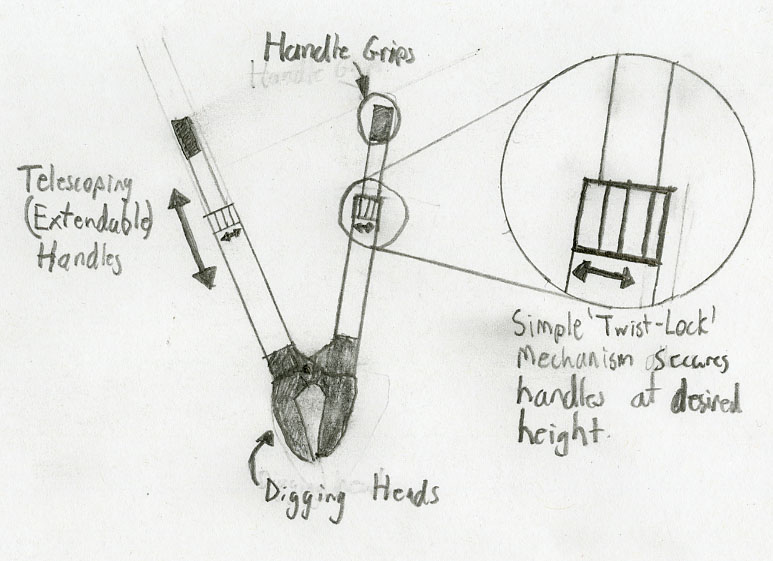Post hole digger redesign
From DDL Wiki
(→Concept 1) |
(→Concept 1) |
||
| Line 248: | Line 248: | ||
== Concept 1 == | == Concept 1 == | ||
| - | [[Image:Telescoping Handle.jpg | + | [[Image:Telescoping Handle.jpg|frame|300px|ndfannana]] |
== Concept 2 == | == Concept 2 == | ||
Revision as of 21:33, 5 October 2008
Contents |
Executive Summary
Research and Observations
Usability Study
In order to get a better understanding of how the user interacts with our product, we conducted two usability studies. To broaden our knowledge on the use of the tool, we chose to examine two subjects -- one male and one female, both college aged. Each user study was conducted in the exact same manner. The user dug a total of 4 holes; 2 with the simple post hole digger and 2 with the complex post hole digger. Of the 2 holes dug with each tool, one was in hard, grassy soil, the other in soft topsoil. The user first dug for 5 minutes in hard, grassy soil using the simple post hole digger. He or she was then given a few minutes to rest, and moved on to digging another hole for 5 minutes with the complex post hole digger. This hole was strategically dug in an area nearby the previous one to maintain a common consistency of the soil. After another brief rest, he or she moved to the soft topsoil. The user dug with the simple tool until 5 minutes was up or a depth of 36” was reached, resting only after this milestone. Lastly, the subject dug in the soft topsoil with the complex digger for 5 minutes or until the 36” depth was reached. Again, the hole was dug near the first one made in the soft topsoil to ensure common soil consistency. Throughout all of the experiments the group members noted the user’s actions, comments, and depth of the hole throughout the process. After finishing the physical testing, the group asked the user to comment on the experience, while also asking specific questions to help prompt them for a particular type of response. A detailed rundown of each study can be found in the following paragraphs.
Study I: Average Female User
- Name of Subject: Laurel Bancroft
- Age: 21
- Height: 5’ – 4”
- Weight: 120 lbs.
- Date: Friday, 9/26/08
Test 1: Simple post hole digger in hard, grassy soil
- Observations made by group:
From the beginning of this test, it was immediately apparent that the soil was going to be quite difficult to dig. After encountering several rocks and a few roots, the user was only able to dig to a depth of 3" after the 5 minute time limit was reached. Throughout the entire experiment the subject struggled with actually removing the dirt from the hole. As the dirt continued to fall out of the shovel before removal, the user became visibly frustrated.
- User comments:
Most of the comments made by the user during the test were fully expected, and helped solidify many initial thoughts and concerns we had with the simple post hole digger. Some of the issues she had with the tool included: banging her knuckles together, difficulty aiming and hitting the hole, fatigue from the weight of the digger, and the fact that the dirt failed to remain in the shovels during removal. She also mentioned that the misalignment of the handles annoyed her, and suggested the use of gloves with the tool.
Test 2: Complex post hole digger in hard, grassy soil
- Observations made by group:
- User comments:
Again, most of the comments made by the user during the test were fully expected. Because she is fairly short, she struggled with the long handles, as demonstrated by Figure 2.1.4. She mentioned that the tool seemed heavier than the simple digger, and she became fatigued much more quickly. Besides these two complaints, her comments were generally positive. She appreciated the knuckle protecting mechanism, liked the sharper tips on the digging head, noting that it enabled her to pierce the ground more easily, and had less trouble aiming the tool in the hole. One bit of humor that arose from one of her comments came when she refused to kill a worm that appeared in the hole. She refused to continue until one of the members removed it.
- General user comments prior to tests 3 and 4:
Before proceeding to the 3rd and 4th tests, we chose to ask the subject for a few general comments based off the performance of the two diggers in the hard, grassy soil. The user noted that if the simple shovel was aligned more accurately and had sharper tips, she’d rather use it because of its light weight. Her reasoning behind this was that she'd personally prefer to use a lighter tool and sacrifice the higher number of reps vs. using a heavier tool requiring fewer strokes. When asked if she had to dig a 6” hole in hard, grassy soil right now, she said she’d choose the complex digger, mostly because her digging rate was twice that of the simple digger.
Test 3: Simple post hole digger in soft topsoil
- Observations made by group:
This particular test went much better than expected. Because the soil was quite loose at all depths, the subject was able to dig to a depth of 36" in just 4 minutes, completely blowing away her performance in the hard, grassy soil. Despite this overall success, the test did show some negative results. Once a depth of about 16" was reached, the user began having issues aiming. After this point, she repeatedly hit the top edge of the hole, caving it in, stroke after stroke. Figure 2.1.5 shows how sloppy the entry to the hole became as the user slowly destroyed it. Also, when the hole became roughly 24" deep, the handles of the digger began hitting the sides of the hole. This phenomenon is depicted in Figure 2.1.6. Throughout the entire experiment the subject struggled with actually removing the dirt from the hole. As the dirt continued to fall out of the shovel before removal, the user became visibly frustrated.
- User comments:
As evidenced by her repeated failure to hit the hole, the subject admitted that she had trouble aiming as the hole became deeper. As a result of slowly caving the top of the hole in, she became timid with her penetrating thrust. She felt that if she slowed her self down a bit, she'd become more accurate. Once she did this, she did become much more accurate with her strokes. Besides these negative aspects, she repeatedly commented on how much simpler it was to dig in the soft soil. She was quite proud of her performance.
Test 4: Complex post hole digger in soft topsoil
- Observations made by group:
Much like was the case with the simple digger, the complex digger performed much faster in the soft soil than it did in the hard, grassy soil. Because of its ability to scoop more dirt in one pass, the subject's digging rate was even faster than that of the simple digger in soft soil. After 1 minute, she'd already reached a depth of 18". At this point, the user reverted to an old technique as discovered in test 1. She began standing aside the tool again, pushing with one hand and pulling with the other. Because the hole was much deeper, she added a slight twist in this technique by turning the hand with which she pushed, upside down. She can be seen doing this in Figure 2.1.7. As the hole became deeper, it became obvious that the increased length of the complex digger compared to that of the simple digger was becoming a problem. She eventually dug by initially grabbing the handles on the grips to get the dirt half way up the hole, but because she was too short to get the entire tool out she tried moving her grip down to the middle of the handles to extract the dirt. This technique often failed, causing a good portion of it to fall out of the shovel. One result worth noting was that, at a depth of 36", the handles of the complex digger came close to, but did not touch the edge of the hole (see Figure 2.1.8). This was interesting to us, because when purchasing the tool this phenomenon was one of its main points of advantage that it claimed over other designs.
- User comments:
While the subject was, again, quite proud of her rapid performance, she did admit that the increased scoop capacity of the complex post hole digger made here tired very quickly. She noted that it seemed very heavy and made her back somewhat sore during use. The subject also recognized that her short stature made it very difficult to dig as the hole deepened. She also complained that bending over to finish the whole made her legs and back sore.
- General user comments following all 4 tests:
Upon completion of all the tests, we chose to ask the subject for a few more general comments regarding the performance of the two diggers. She claimed that the simple digger was much easier to pull apart than the complex version, but its construction seemed to be lacking. Its poor alignment was annoying, and the wood handles seemed as if they could easily splinter or break. Some complaints she had regarding the complex digger included the length of the handles being too long, and the difficulty she had pulling the handles apart when compared to the simple version. A complaint common to both models was that the diameters of the handles were a little too large, causing her hands to hurt after performing each test. When asked if she had to dig a 36” hole in soft soil, she would've preferred using the simple tool, mainly for its light weight. When asked which tool she would choose in a store and why, she said she would’ve chosen the complex digger for the following reasons:
- ·The sharp tips allow you to get better penetration
- ·She would’ve assumed they were both the same weight even though the complex tool was quite a bit larger. This :was because it seemed to her like it was made of more high-tech material, meaning it wouldn’t have weighed any :more than the simple digger.
- ·Since the complex tool was twice as expensive, she'd have assumed that expense meant a better product
When the idea of using a gas powered auger was proposed, she said just not knowing how to use one would completely deter her from using it, plus the danger involved was not appealing. She’d have gone with one of the mechanical versions instead.
Study II: Average Male User
- Name of Subject: Ryan Chehanske
- Age: 20
- Height: 6’ – 0”
- Weight: 240 lbs.
- Date: Monday, 9/29/08
Test 1: Simple post hole digger in hard, grassy soil
- Observations made by group:
As expected, the increased size and strength of the subject provided some fairly different results. Again, the soil was quite rocky and contained roots, but the user overcame these obstacles fairly well. The poor soil conditions are depicted in Figure 2.1.9. After just 2 minutes of digging, he'd already eclipsed the female subject's hole depth and had reached 5". Despite this early success, his performance fizzled out, allowing him to reach a depth of only 7" at the 5 minute time limit. One technique used by this subject that differed from the female user was his penetration thrust. When preparing to thrust the tool into the ground, rather than gripping each handle individually, the user was closing the tool and wrapping both hands around the two handles simultaneously. He can be seen doing this in Figure 2.1.10. Much like the female user, throughout the entire experiment the subject struggled with removing the dirt from the hole. As the dirt continued to fall out of the shovel before removal, this user became even more visibly frustrated.
- User comments:
Most of the comments made by the user during this test were aligned with those of the female subject. He complained about the tool's misalignment, claimed his hands were hurting afterwards, and was extremely annoyed by the dirt continually falling from the shovels. When asked how difficult it was to aim the tool and hit the hole, he said it was not an issue.
Test 2: Complex post hole digger in hard, grassy soil
- Observations made by group:
One of the interesting results of this particular experiment involved the subject utilizing an unexpected technique when pulling the handles apart. Rather than pulling apart with both palms grasping the outer edges of the handles, he rolled his wrists over, holding the inside of the handles instead (see Figure 2.1.11). Besides this observation, the only other noticeable thing was his speed. After 2 minutes he'd already dug 6" of dirt, and when the 5 minutes was finally up he'd reached a depth of 10", as shown in Figure 2.1.12. Again, this was nearly twice as deep as the corresponding test for the female user.
- User comments:
The male subject immediately noticed how much more difficult it was to pull the complex digger's handles apart, making note that this was the most difficult part of using the tool. One particular complaint he had dealt with the tool's initial alignment. Because of the knuckle protector the handles are spread apart somewhat before entering the ground, making it penetration a different process biologically. The user complained that because of this, he was forced to use his forearms more than before, exhausting them relatively quickly. The subject also pointed out that the handles seemed to deflect a lot more than those of the simple digger. When asked about the weight and aiming of the tool, he said both were not a problem at all. The user did recognize that this particular tool digs a larger diameter hole, and its edges were quite a bit cleaner. He pointed out how nice it was that this tools digging heads completely seal the dirt in when trying to extract it -- one of the positive observations made repeatedly by both users.
- General user comments prior to tests 3 and 4:
The only comment the user had before proceeding to the soft soil was that he'd much rather prefer to use the complex post hole digger at this point.
Test 3: Simple post hole digger in soft topsoil
- Observations made by group:
After experiencing how much easier it was for the female user to dig in the soft topsoil, we had high expectations for the male subject for this test. He definitely performed as expected, making quick work of the hole. The subject was able to dig to a depth of 27" in just 1 minute, completely blowing away the female user's performance in the her respective test. He eventually reached the 36" mark after just 2 minutes of digging! Despite this overall success, the test did reveal some negative results. Once a depth of about 24" was reached, the user began having issues with having to bend over. Figure 2.1.13 demonstrates how far the user had to bend over when removing the dirt. Another observation made was that the wet soil near the bottom of the hole stuck to the digging heads quite a bit, forcing the user to tap the tool's tip on the ground beside him to remove it. Once the hole was near its final depth, it became obvious that the tool's handles were restricted by the hole's edge, as seen in Figure 2.1.14. This agrees with the corresponding test performed by the female subject.
- User comments:
Overwhelmed with how soft and light the soil was, the user couldn't stop commenting on how much easier it was to dig in the "soft stuff". The user also verified one of our observations, complaining about the length of the handles. Because they're fairly short, he had to bend over when the hole deepened. He mentioned that it wouldn't have been enough to bother him in just 2 minutes of digging, but if he was working all day, it would've been much more problematic.
Test 4: Complex post hole digger in soft topsoil
- Observations made by group:
As established before, it was apparent immediately that the complex tool was able to get much more dirt with one scoop. It seemed as if this may have made him tired quickly, because it took him 3 minutes to finish the hole, whereas with the simple digger, it only required 2 minutes. One interesting thing the user did during this study was the use of two piles for dumping the dirt. We weren't quite sure why he did it, but it definitely made cleanup a little more difficult when he finished digging. It seemed as if the inverted handle grip technique was a staple for the male user, as he can be seen doing it again in Figure 2.1.15. Another interesting observation was the extreme deflection of the fiberglass handles. This phenomenon can be seen in Figure 2.1.16. Other observations made that mirrored those of previous tests included: dirt sticking to the shovel heads, the handles not touching the edge of the hole upon completion, and the use of the technique of standing aside the tool during use, pushing one handle and pulling the other, rather than pulling both from a centered stance.
- User comments:
The user repeated noticing that the handles of this digger weren't fully together when beginning his downward thrust (due to the knuckle protector piece). Because of this, it made it hard for him to pull the handles apart at the bottom of the hole – it seemed like there wasn't enough room to open them. He added that he would've strongly preferred that the handles be closer together initially. The user also commented about the complex digger's increased scoop capacity. Because you can get so much more dirt with one scoop, it made the tool fairly heavy, making the work seem a bit harder than when using the simple digger. Again, he complained about how difficult it was to pull the digger's handles apart, suggesting that we lube them up next time.
- General user comments following all 4 tests:
One major observation that the male subject pointed out, was that it seems like no matter which tool you use and what type of soil you’re digging in, most of the work is done within the first 60 seconds or so. After that point, it's as if you’re just meticulously picking away at the dirt and getting nowhere. The user praised the complex digger for it's ability to pierce the ground and seal the dirt in upon removal, but mentioned that it was much more physically demanding to use than the simple digger. When asked which tool he’d choose if he had to dig a 36” hole in hard soil right now, he said he’d much rather use the complex digger because this tool has sharper digging heads to penetrate the soil and it seals the dirt in better when clamped shut. On the contrary, when asked which tool he’d choose if he had to dig a 36” hole in soft soil right now, he said he’d much rather use the simple digger. He liked the fact that this tool’s handles are closer together. He added that if the dimple digger had sharper tips, could somehow seal the dirt in the digging heads, and had a more efficient scoop capacity, he’d choose it over the complex design. With long term use, this user felt that the complex digger would break first. Either one of the bolted connections would break or come loose, or the handle would break. His reasoning for this was that it seemed like the handles were deflecting quite a bit when using it. When asked which tool he would choose in a store and why, he said he would’ve chosen the complex digger for the following reasons:
- ·The sharp tips allow you to get better penetration
- ·You get more bite with one thrust
- ·The grips on the handles are nice
- ·The complex digger looks beefier and nicer, and is more attractive
When the idea of using a gas powered auger was brought up, the user had the following to say: "If I had to dig 20 holes in a day, I’d definitely use a gas powered auger. The benefits of its speed and ease would far outweigh the risks and expense involved with using an auger. On the other hand, if I had to dig, say, 4 holes in a day, I’d use the complex digger. It’d be more practical than the auger, relatively cheap, and just makes more sense."
- Conclusions
- User strength affects the ability to aim the tool
- User height affects one's ability to use the complex digger
- Misalignment of the simple tool is fairly annoying
- The simple tool is much easier to use, especially when pulling the handles apart
- The sharp teeth of the complex digger's shovels are nice for penetration
- The complex tool's claim for digging deeper holes seems relevant and justified
- Looks mean a lot when purchasing a post hole digger in a store
- The complex tool's ability to seal the dirt in is a strong advantage
- Soil quality plays a huge role in digging rate
- The increased scoop capacity of the complex digger makes the user tired quickly
- Bending over is annoying
- Average male user digs about twice as fast as his female counterpart
- Most of the work is done in the first few minutes, then the soil gets really hard
Market Research
Areas for Improvement
Expert Analysis
In order to gain further insight into the usability of our product and possible areas of improvement, we talked to two experts who have used post hole diggers for a significant period of time. Both of these experts gave similar recommendations as to how the product could be improved. We met the two experts during a trip to Home Depot in East Liberty, on Sunday, September 28th, 2008. Both experts provided useful insight on how the product is used and can be improved, which are summarized below.
| Expert 1 | Expert 2 | |
|---|---|---|
| Name | James | Andrea |
| Age | ~45 years old | ~55 years old |
| Notes |
|
|
We asked each expert to describe their process of using the tool, and somewhat unsurprisingly, got answers that were quite similar to what we came across in our own experience of using the products. However, both were able to provide excellent feedback on desired changes or redesigns to a post hole digger. Below, the main improvements that they recommended are presented.
| Improvement | Reasons | Notes |
|---|---|---|
| Improved digging heads |
|
|
| Telescoping Handles |
|
|
| Knuckle Bar |
|
|
| Compact Digging Head Closing Mechanism |
|
|
Both experts also presented us with a variety of observations from their use with post hole diggers over the years. Both recommended against using augers unless absolutely necessary, due not just to their high cost and environmental damage, but to the difficulty in using them and the possibility of injury when using powered augers. Also, due to the difficulty in penetrating hard soil, both experts would often wait until after it had rained to dig holes. However, this method would usually only help in the initial foot of digging. Regardless of whether or not this was done, both found that handles were likely to break or give the user splinters. Soft soil can also present challenges when digging holes, as the user has to be careful to prevent the hole from collapsing. Finally, both recommend the use of a tamping bar to deal with rock, especially given the abundance of flagstone in and around the Pittsburgh area.
Design Concepts
Through our extensive research and user studies, we identified several problem areas with the post hole diggers and potential opportunity for improvement in these areas. This lead to the development of a large number of possible solutions that was eventually narrowed down to the four concepts presented below.


